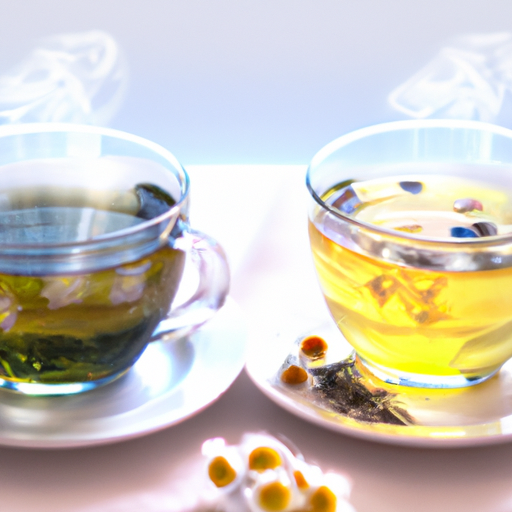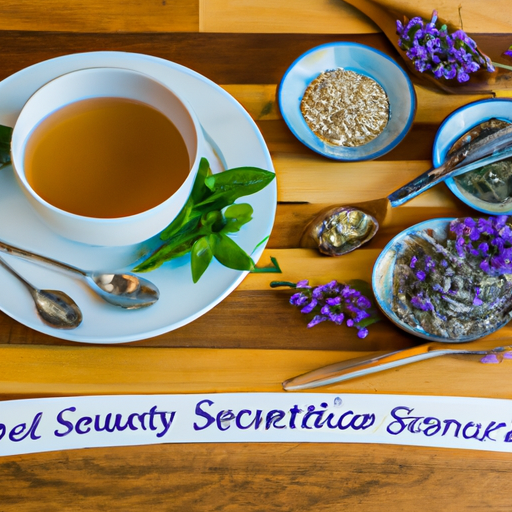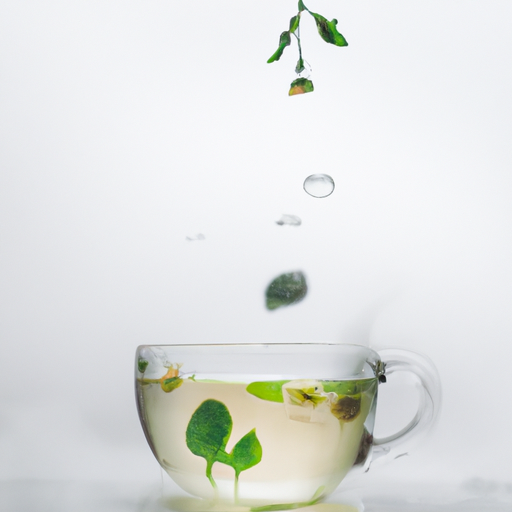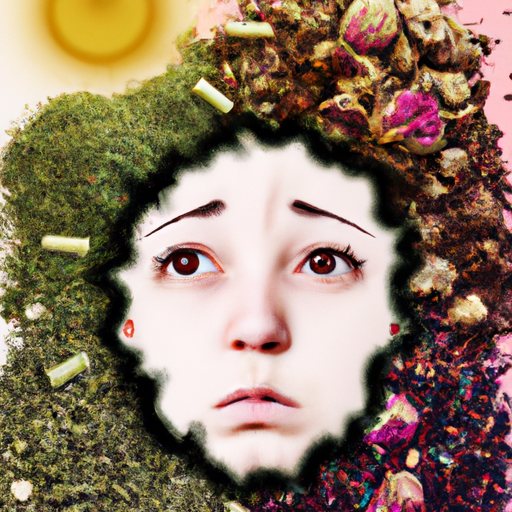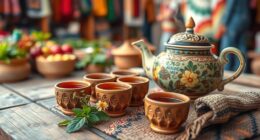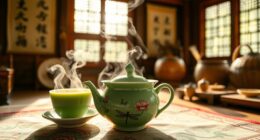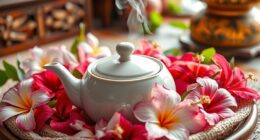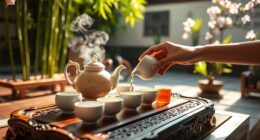Picture yourself waking up to the soothing scent of a hot cup of tea, with steam swirling around you, embracing your senses.
As a tea enthusiast, I have always been fascinated by the diverse world of teas and the unique experiences they offer. One question that often arises is, ‘What is the difference between tea and herbal tea?’ Let me take you on a journey to explore the subtle nuances that set these two beverages apart.
Traditional tea, derived from the Camellia sinensis plant, comes in various forms such as black, green, white, and oolong tea. Each variety boasts distinct flavors and aromas, thanks to the processing methods employed.
On the other hand, herbal tea, also known as tisanes, is a blend of various herbs, flowers, fruits, and spices, offering a wide range of flavors and invigorating scents.
Beyond taste, another aspect that differentiates these beverages is their caffeine content. While traditional teas contain varying levels of caffeine, herbal teas are naturally caffeine-free, making them a popular choice for those seeking a soothing and relaxing drink.
Join me as we delve deeper into the origins, health benefits, preparation methods, and cultural significance of tea and herbal tea. Together, we will uncover the captivating world of these beverages and discover our own personal preferences along the way.
Key Takeaways
- Traditional tea is made from the Camellia sinensis plant, while herbal tea is a blend of herbs, fruits, flowers, and spices.
- Traditional tea contains caffeine, while herbal tea is caffeine-free.
- Traditional tea flavors range from delicate to bold, while herbal tea offers diverse taste experiences with flavors like chamomile, peppermint, and hibiscus.
- Traditional tea is rich in antioxidants, such as catechins and flavonoids, while herbal teas have unique health benefits and offer overall well-being support.
Origins of Traditional Tea and Herbal Tea
Let’s delve into the fascinating origins of traditional tea and herbal tea!
The origins of traditional tea can be traced back to ancient China, where it was first discovered by Emperor Shen Nong around 2737 BC. Legend has it that while sitting beneath a tree, a few leaves fell into his cup of hot water, creating a delicious infusion that we now know as tea. From there, the cultivation and consumption of tea spread throughout China and eventually reached other parts of the world.
On the other hand, the history of herbal tea dates back even further. Ancient civilizations, including the Egyptians and the Greeks, have been using herbs and plants for medicinal purposes for thousands of years. The infusion of these herbs in hot water created a beverage that not only had healing properties but also a pleasant taste. This practice eventually evolved into what we now call herbal tea.
Moving on to the next section about flavors and aromas, it’s important to note that both traditional tea and herbal tea offer a wide range of flavors and aromas. However, their sources differ. Traditional tea, derived from the Camellia sinensis plant, can have flavors ranging from delicate and floral to bold and robust. Herbal tea, on the other hand, derives its flavors and aromas from various herbs, fruits, flowers, and spices, offering a diverse array of taste experiences.
So, let’s explore the enchanting world of tea flavors and aromas together!
Flavors and Aromas
When it comes to traditional tea, there’s a wide range of flavors to explore. From the bold and robust taste of black tea to the delicate and grassy notes of green tea, each variety offers a unique experience.
On the other hand, herbal teas offer a whole different world of flavors and aromas. Whether it’s the soothing and floral taste of chamomile, the refreshing and minty flavor of peppermint, or the tart and vibrant hibiscus, herbal teas provide a diverse range of options for those looking for something different.
Range of flavors in traditional tea (e.g., black, green, oolong)
Explore the vast array of flavors that traditional tea offers, from the robust and bold taste of black tea to the delicate and grassy notes of green tea. Traditional tea comes in various types, each with its unique flavor profile.
Black tea, known for its richness, offers a full-bodied taste that’s often accompanied by hints of malt, caramel, or even fruitiness. Green tea, on the other hand, is characterized by its fresh and vegetal flavors, often described as grassy or seaweed-like. Oolong tea falls somewhere in between, offering a range of flavors that can be floral, fruity, or even toasty.
Tea tasting techniques, such as steeping time and water temperature, can further enhance these flavors.
Transitioning into the subsequent section, herbal tea provides a whole new world of unique flavors and aromas, such as chamomile, peppermint, and hibiscus.
Unique flavors and aromas in herbal tea (e.g., chamomile, peppermint, hibiscus)
Herbal tea offers a myriad of unique flavors and aromas, such as the soothing floral notes of chamomile, the refreshing minty taste of peppermint, and the vibrant tartness of hibiscus.
These herbal teas not only provide a delightful sensory experience but also come with various health benefits. Chamomile, for instance, is known for its calming properties and can aid in reducing anxiety and promoting better sleep.
On the other hand, hibiscus is rich in antioxidants and may help lower blood pressure and improve heart health. Peppermint tea is widely recognized for its ability to alleviate digestive issues and reduce inflammation.
With such a wide range of flavors and potential health benefits, herbal teas are a fantastic alternative to traditional teas.
Moving forward, let’s explore the caffeine content found in different types of tea.
Caffeine Content
Caffeine content is an important consideration when it comes to tea. Caffeinated teas, such as black, green, and oolong, contain varying amounts of caffeine, which can provide a stimulating effect.
On the other hand, herbal teas are typically caffeine-free, making them a popular choice for those looking to avoid caffeine or enjoy a calming beverage before bed.
Caffeinated teas (e.g., black, green, oolong)
When it comes to caffeinated teas like black, green, and oolong, you’ll find a range of flavors and aromas to suit your taste buds and provide a gentle energy boost. These teas contain varying amounts of caffeine, with black tea having the highest caffeine content, followed by oolong and green tea.
The caffeine in these teas can provide a stimulating effect on the central nervous system and can help improve focus and concentration. Additionally, caffeinated teas have been associated with several health benefits, including improved heart health, increased metabolism, and enhanced antioxidant activity. However, it’s important to note that the caffeine content in these teas can vary depending on factors such as brewing time and temperature.
Transitioning into the subsequent section, herbal teas are typically caffeine-free, making them a popular choice for those looking to avoid caffeine altogether.
Herbal teas are typically caffeine-free
If you’re looking for a soothing beverage that won’t keep you up at night, there’s nothing quite like a cup of herbal tea. Herbal teas are typically caffeine-free, making them the perfect choice for those who want to unwind without the jitters.
When it comes to flavors, herbal teas offer a wide range of options to suit every palate. From minty and refreshing peppermint tea to floral and calming chamomile tea, there is something for everyone.
Additionally, herbal teas are known for their potential health benefits. For example, chamomile tea is believed to aid in digestion and promote relaxation, while ginger tea is often used to soothe an upset stomach. These natural infusions can be a delicious way to support your well-being.
Moving into the next section, let’s explore the potential health benefits of herbal teas.
Potential Health Benefits
When it comes to potential health benefits, traditional tea is known for its antioxidant properties, which can help to protect the body against free radicals and reduce the risk of chronic diseases.
Additionally, different herbal teas offer specific health benefits. For example, chamomile tea is often used for relaxation and promoting sleep, while ginger tea is known for its digestion-boosting properties.
Antioxidant properties of traditional tea
To understand the antioxidant properties of traditional tea, you’ll be surprised to learn that a single cup of black tea contains more antioxidants than a serving of broccoli. Antioxidants are compounds that help protect the body against damage caused by free radicals, which are unstable molecules that can lead to various health problems.
Traditional tea, such as black, green, and oolong tea, is rich in antioxidants called catechins and flavonoids. These antioxidants have been found to have numerous health benefits, including reducing the risk of chronic diseases like heart disease and certain types of cancer.
In comparison with herbal remedies, traditional tea generally contains higher levels of antioxidants. However, it’s important to note that herbal teas also have their own unique health benefits.
In the subsequent section, we’ll explore the specific health benefits associated with different herbal teas, such as chamomile for relaxation and ginger for digestion.
Specific health benefits associated with different herbal teas (e.g., chamomile for relaxation, ginger for digestion)
Chamomile tea is like a warm embrace, soothing and relaxing both the body and mind. It has been used for centuries as a natural remedy for sleep problems, thanks to its calming properties. Peppermint tea, on the other hand, is known for its ability to aid digestion and relieve stomach discomfort. These herbal teas offer specific health benefits that go beyond traditional tea. To help you understand the benefits of different herbal teas, I have created a table showcasing some popular options:
| Herbal Tea | Health Benefit |
|---|---|
| Chamomile | Promotes relaxation and sleep |
| Peppermint | Aids digestion and relieves stomach discomfort |
Now that we have explored the specific health benefits of herbal teas, let’s dive into the next section about preparation and brewing methods. It’s important to know how to make the most out of these teas to fully enjoy their benefits.
Preparation and Brewing Methods
If you want to experience the full flavor and benefits of tea, it’s important to know the different brewing methods that can be used. Here are three brewing techniques to consider:
-
Steeping Time: The steeping time can vary depending on the type of tea you’re brewing. For black teas, a steeping time of 3-5 minutes is generally recommended. Green teas, on the other hand, should be steeped for 2-3 minutes to avoid bitterness. Herbal teas often require a longer steeping time of around 5-7 minutes to extract the full flavor and medicinal properties.
-
Water Temperature: The water temperature also plays a crucial role in brewing tea. For black teas, use boiling water at around 212°F (100°C). Green teas, on the other hand, should be brewed with water at a lower temperature, around 160-180°F (71-82°C). Herbal teas can be brewed with boiling water, as they’re more forgiving when it comes to temperature.
-
Infusion Method: There are various ways to infuse tea, including using tea bags, infusers, or loose tea leaves. Each method can produce different flavors and strengths. Using loose tea leaves in a strainer or infuser generally allows for a better infusion and more control over the brewing process.
Understanding these brewing techniques will help you make the most of your tea experience.
Now, let’s delve into the cultural significance and traditions surrounding tea.
Cultural Significance and Traditions
Immerse yourself in the rich tapestry of cultural significance and cherished traditions that surround the world of tea, and let its timeless allure captivate your senses. Tea has been an integral part of cultures across the globe for centuries, with each region embracing its own unique customs and practices. From elaborate tea ceremonies in Japan to the vibrant tea stalls of India, tea holds a special place in the hearts of people worldwide.
To truly appreciate the cultural significance of tea, it is important to understand the traditional practices associated with it. These practices vary greatly depending on the country and even the community within it. In China, for example, tea is often served during important celebrations and gatherings as a symbol of respect and hospitality. In Morocco, the art of preparing and serving mint tea is considered a form of hospitality and friendship. These rituals not only enhance the flavor of the tea but also create a sense of connection and unity among participants.
To delve deeper into the cultural significance and traditions surrounding tea, let’s take a look at a comparison table showcasing some of the notable practices in different countries:
| Country | Traditional Practice |
|---|---|
| China | Tea ceremonies |
| Japan | Matcha preparation |
| India | Chai stalls |
| Morocco | Mint tea rituals |
Understanding these cultural practices not only allows us to appreciate the beauty and history behind tea but also helps us connect with others who share the same passion. As we move into the next section about personal preferences and recommendations, we will explore how these cultural traditions influence our own tea choices and rituals.
Personal Preferences and Recommendations
To truly savor the sublime taste of tea, we must explore our personal preferences and recommendations, allowing our senses to surrender to the tantalizing flavors and aromas. When it comes to choosing between tea and coffee, personal preferences play a significant role. Some people may find the bold and robust flavor of coffee more appealing, while others may prefer the delicate and nuanced taste of tea. It ultimately boils down to individual taste and the desired effect one seeks from their beverage.
Within the realm of tea, various types and flavors exist, each catering to different palates. For those who enjoy a strong and invigorating brew, black tea might be the perfect choice. Its rich, full-bodied flavor provides a satisfying kick, reminiscent of a morning cup of coffee. On the other hand, green tea offers a more delicate and refreshing experience, with its grassy notes and subtle sweetness.
When it comes to tea ceremonies, cultural significance and traditions come into play. The meticulous and graceful rituals associated with tea ceremonies can enhance the enjoyment of the tea-drinking experience. Following these traditions, such as the Japanese tea ceremony, can bring a sense of tranquility and mindfulness to the act of sipping tea.
Exploring personal preferences and recommendations is key to finding the perfect tea for oneself. Whether it’s the boldness of black tea or the subtlety of green tea, the world of tea offers a multitude of flavors and experiences to suit every taste. Additionally, embracing the cultural significance and traditions of tea ceremonies can elevate the enjoyment of this ancient beverage. So, sit back, relax, and embark on a journey of tea discovery.
Frequently Asked Questions
Can herbal tea be made from the same plant as traditional tea?
No, herbal tea is not made from the same plant as traditional tea. Herbal tea is made from various plants and herbs, such as chamomile and peppermint. It has different potential health benefits and there are many common types of herbal tea available.
Are there any potential side effects or risks associated with drinking herbal tea?
Drinking herbal tea in moderation can have potential health benefits. However, it’s important to be aware of potential side effects and risks. Always follow the recommended dosage and consult with a healthcare professional if needed.
Can herbal tea be considered a suitable substitute for traditional tea in terms of taste and benefits?
Herbal tea can be a suitable substitute for traditional tea in terms of taste and benefits. It offers a wide range of flavors and health benefits, making it a refreshing and beneficial choice for tea lovers.
How does the caffeine content in herbal tea compare to traditional tea?
When comparing caffeine content in herbal tea and traditional tea, it’s important to note that herbal teas are typically caffeine-free, while traditional teas like black and green tea contain caffeine. This can impact one’s health depending on their caffeine sensitivity.
Are there any specific brewing techniques or time recommendations for different types of herbal tea?
For different types of herbal tea, there are specific brewing techniques and time recommendations. It’s important to follow these guidelines to ensure the best flavor and benefits.
Conclusion
In conclusion, the difference between tea and herbal tea lies in their origins, flavors, caffeine content, potential health benefits, preparation methods, and cultural significance.
While traditional tea is derived from the leaves of the Camellia sinensis plant and offers a wide range of flavors and varying caffeine levels, herbal tea is made from herbs, fruits, flowers, and spices, providing a diverse array of unique tastes and zero caffeine.
Whether you prefer the comforting embrace of a warm cup of tea or the refreshing infusion of herbal tea, both offer a delightful experience to cater to individual preferences.
So, next time you’re looking to unwind or invigorate your senses, remember that tea and herbal tea are like two sides of the same coin, each offering its own distinct charm and benefits.

